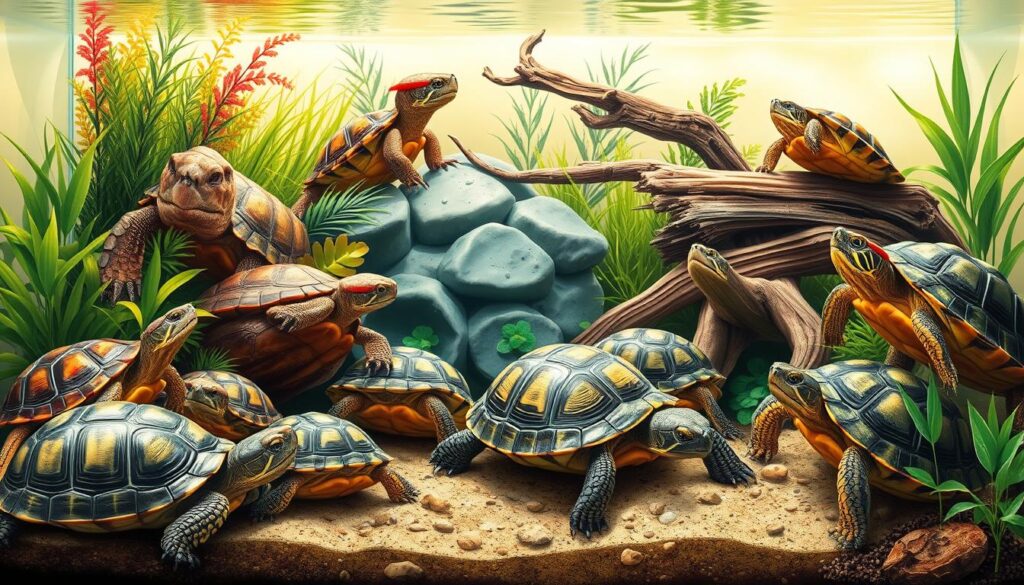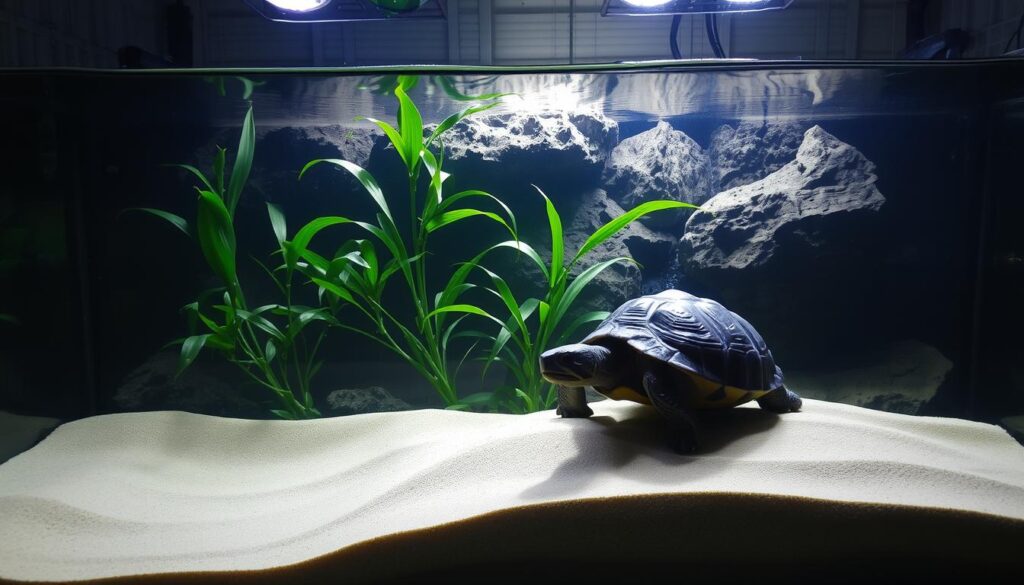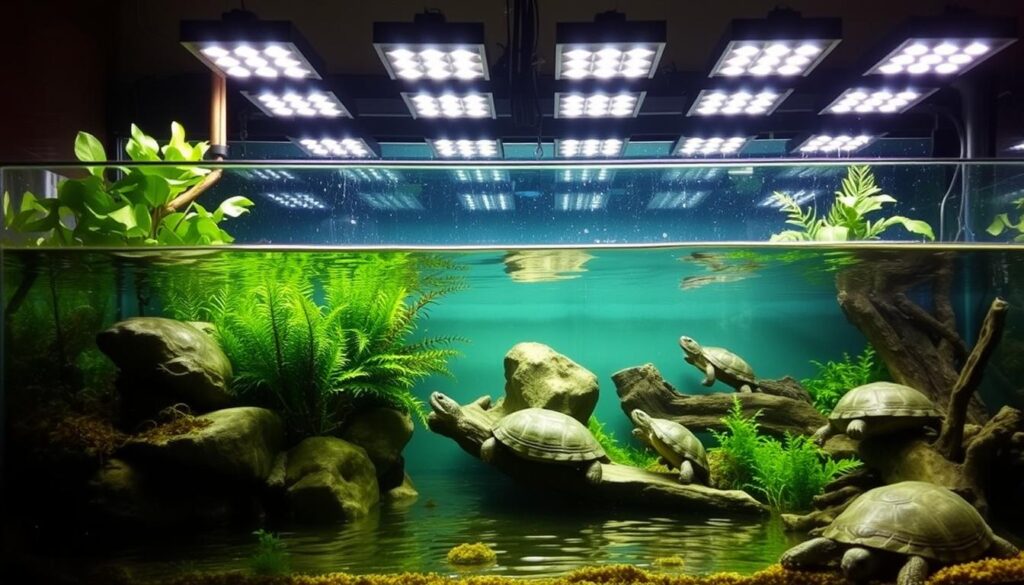Hey there, fellow turtle enthusiasts! Are you ready to dive into the wonderful world of aquatic turtles? We’re excited to share our knowledge with you on how to care for these amazing creatures.
Caring for turtles in an aquarium can be a rewarding hobby, but it requires a commitment to providing the right environment and care. From setting up the perfect tank to understanding their dietary needs, we’ve got you covered!
We’ll explore the essential tips and tricks for keeping your aquatic turtles happy and healthy. With the right guidance, you’ll be well on your way to creating a thriving environment for your turtles.
Key Takeaways
- Understand the importance of proper turtle care
- Learn how to set up the perfect tank for your turtles
- Discover the dietary needs of your aquatic turtles
- Get tips on maintaining a healthy environment
- Find out how to keep your turtles happy and thriving
Understanding Aquatic Turtles as Pets
Bringing an aquatic turtle into your family can be a thrilling adventure, but it’s crucial to understand what you’re getting into! Aquatic turtles are fascinating creatures that require specific care and attention. As you explore the world of turtle keeping, you’ll discover that different species have unique needs.
Popular Species for Home Aquariums
Some popular aquatic turtle species for home aquariums include red-eared sliders, painted turtles, and map turtles. These turtles are relatively easy to care for and can thrive in a well-maintained aquarium. Red-eared sliders, for instance, are known for their vibrant red stripes and can grow quite large, while painted turtles are admired for their colorful markings. When choosing a species, consider factors like size, temperament, and dietary needs.
It’s also essential to research the specific needs of each species to ensure you can provide the best possible environment. For example, some turtles are more social and may require tankmates, while others prefer to be alone.
Lifespan and Growth Expectations
Aquatic turtles can live for 20-30 years or more with proper care, so it’s vital to understand their lifespan and growth expectations. Red-eared sliders, for instance, can grow up to 12 inches in length, while painted turtles typically remain smaller, around 5-6 inches. Understanding these growth patterns will help you plan for the long-term care of your turtle.
By knowing what to expect, you can better prepare to provide a happy and healthy home for your aquatic turtle. This includes planning for the right tank size, diet, and environmental conditions that support their growth and well-being.
Types of Pet Turtles Suitable for Aquariums
Choosing the right turtle species for your aquarium is crucial for their health and happiness. With so many types of pet turtles out there, it can be a bit daunting to decide which one is right for you!

Beginner-Friendly Turtle Species
If you’re new to turtle keeping, you might want to consider species like the red-eared slider or the painted turtle. These turtles are relatively easy to care for and can thrive in a well-maintained aquarium. As beginner-friendly options, they are great for those just starting out.
Space Requirements Based on Species
The rule of thumb for turtle tank size is to provide at least 10 gallons of tank space per inch of turtle length. So, for a 4-inch turtle, you’d need a 40-gallon tank. Different species have different space requirements, so it’s essential to research the specific needs of your turtle.
Single vs. Multiple Turtle Setups
While it’s possible to keep multiple turtles in the same tank, it’s crucial to ensure your tank is large enough to accommodate them comfortably. As a general rule, it’s best to start with a single turtle and then consider adding more once you’ve gained more experience. “The key to a harmonious multi-turtle setup is a spacious tank with plenty of hiding spots and visual barriers,” says a renowned turtle expert.
By considering these factors, you can create a happy and healthy environment for your pet turtles. Whether you’re a seasoned turtle keeper or just starting out, understanding the needs of your turtles is key to their well-being.
Read Also Tiny White Worms in Aquarium? Here’s What They Are and How to Get Rid of Them Fast
Essential Turtle Tank Setup Guide
Creating a happy home for your turtle starts with the right tank setup – let’s dive into the essentials! Setting up a turtle tank is not just about throwing some water and rocks together; it requires careful planning to ensure your turtle thrives.
Tank Size Requirements
When it comes to tank size, the general rule of thumb is to provide at least 10 gallons of water per inch of turtle length. So, if you have a 5-inch turtle, you’ll need a tank that’s at least 50 gallons. But why so big? Turtles need space to swim and grow, and a larger tank helps maintain stable water conditions, making it easier to keep your turtle healthy.
Creating Dry Basking Areas
A dry basking area is crucial for your turtle’s health, as it allows them to climb out of the water, dry off, and soak up some warmth. You can create a basking area using rocks, a floating log, or even a commercial turtle dock. Just make sure it’s big enough for your turtle to comfortably climb out and bask.

As “Turtles need a place to call their own”, a well-designed basking area is a must-have. You can also add some plants or decorations around the basking area to make it more appealing.
Water Depth Considerations
Water depth is another critical factor in your turtle tank setup. The water should be deep enough for your turtle to swim comfortably, but not so deep that it can’t easily reach the surface. A good rule of thumb is to have water that’s at least 1.5 to 2 times deeper than your turtle’s length. This allows your turtle to swim and dive without struggling to reach the surface.
By following these guidelines, you’ll be well on your way to creating a happy and healthy home for your turtle. Remember, a well-designed tank is the foundation of a thriving turtle – so take the time to get it right!
Keeping Turtles in an Aquarium: Environmental Needs
To keep your turtles happy and healthy, you need to get their environment just right! This means paying close attention to several key factors that will make or break your turtle’s quality of life.
Water Temperature Management
Managing water temperature is crucial for your turtle’s health. Most aquatic turtles thrive in water temperatures between 75-85°F. You can achieve this by using a submersible heater, which will help maintain a stable temperature. Make sure to choose a heater that’s suitable for your tank size!

Humidity and Air Circulation
Humidity is another vital aspect of your turtle’s environment. You can maintain the right humidity level by ensuring there’s adequate water in the tank and using a hygrometer to monitor the humidity levels. Proper air circulation is also essential to prevent respiratory issues in turtles.
Seasonal Adjustments
Just like us, turtles can be affected by seasonal changes! You may need to make adjustments to their environment accordingly. For example, some turtles may require a slight drop in temperature during the winter months to simulate their natural habitat. Research your turtle’s specific needs to make the necessary adjustments.
By getting these environmental factors right, you’ll be well on your way to creating a thriving aquatic turtle habitat that will keep your turtles happy and healthy for years to come!
Turtle Tank Filtration Systems
Keeping your turtle tank clean is a top priority, and that’s where a reliable filtration system comes in! A good filtration system is crucial for maintaining a healthy environment for your turtles. It helps remove waste products, excess food, and other contaminants that can harm your pets.
Types of Filters for Turtle Tanks
There are several types of filters you can use in your turtle tank, each with its own advantages. Let’s take a look at some of the most popular options:
- Canister Filters: These are highly effective and offer excellent mechanical and biological filtration. They’re ideal for larger tanks.
- Hang-on-Back Filters: Easy to install and maintain, these filters are great for smaller to medium-sized tanks.
- Internal Filters: These filters are submerged inside the tank and are suitable for smaller tanks or for providing additional filtration.
Filter Maintenance and Cleaning
Regular maintenance is key to keeping your filtration system running smoothly. Here are some tips:
- Clean the filter media regularly to prevent clogging.
- Replace worn-out parts as needed.
- Monitor water parameters to ensure they’re within safe ranges for your turtles.
Remember, a well-maintained filter is essential for a healthy turtle tank!
Dealing with Turtle Waste
Turtle waste can be a significant challenge in maintaining a clean tank. Here are some strategies to help manage it:
| Strategy | Description | Benefits |
|---|---|---|
| Regular Water Changes | Replace 25-50% of tank water weekly | Reduces waste buildup and maintains water quality |
| Effective Filtration | Use a high-quality filter suitable for your tank size | Removes waste products and excess food |
| Monitor Feeding | Avoid overfeeding your turtles | Reduces waste generation |
By implementing these strategies and maintaining a good filtration system, you can keep your turtle tank clean and healthy, ensuring a happy environment for your pets.
Lighting and Heating for Aquatic Turtle Habitats
Creating a comfortable environment for your aquatic turtle starts with understanding the importance of proper lighting and heating in their tank. You see, turtles need a specific setup that mimics their natural habitat to thrive. Let’s explore the key components that’ll make your turtle feel right at home!
UVB Lighting Requirements
UVB lighting is crucial for your turtle’s health as it helps them synthesize vitamin D3, essential for calcium absorption and bone health. You can provide UVB lighting using specialized bulbs or LED lights. It’s recommended to replace these bulbs every 6-8 months, as their effectiveness diminishes over time. Make sure to position the UVB light in a way that it’s not more than 12 inches away from your turtle’s basking spot.

Basking Spot Temperature
The basking spot temperature is another critical factor in your turtle’s tank. It should be around 85-90°F, which is warmer than the water temperature. You can achieve this by using a heat lamp or a ceramic heat emitter. It’s essential to monitor the temperature closely to prevent it from getting too hot or cold, as this can be harmful to your turtle.
Day/Night Cycle Management
Just like in nature, turtles need a day/night cycle. To simulate this, you’ll need to manage the lighting in their tank. A good rule of thumb is to keep the lights on for 10-12 hours a day and off for the remaining 12-14 hours. This cycle helps regulate your turtle’s natural behaviors and promotes a healthy sleep pattern.
Feeding Pet Turtles: Nutrition Guidelines
Feeding your pet turtle a balanced diet is crucial for its overall health and well-being! A nutritious diet can help prevent health issues, promote growth, and ensure your turtle lives a long and happy life. In this section, we’ll explore the different aspects of turtle nutrition, from commercial foods to fresh food options and feeding schedules.
Commercial Turtle Foods
Commercial turtle foods are a convenient and nutritionally balanced option for your pet. These foods come in various forms, such as pellets, sticks, or flakes, and are formulated to meet the nutritional needs of turtles. When choosing a commercial food, look for products that are high in protein, fiber, and vitamins, and low in fat. Some popular brands include Tetra and API. Always follow the manufacturer’s instructions for feeding amounts and frequencies.

Fresh Food Options
In addition to commercial foods, fresh foods can provide a delicious and nutritious supplement to your turtle’s diet. Leafy greens like kale, collard greens, and dandelion greens are rich in vitamins and minerals. You can also offer your turtle a variety of vegetables, such as carrots, sweet potatoes, and squash. Fruits like berries, melons, and apples can be given in moderation. Remember to chop or grate the foods to prevent choking hazards and ensure easy digestion.
Feeding Schedule by Age
The feeding schedule for your turtle will depend on its age. Young turtles require more frequent feeding than adults. Here’s a general guideline:
- Hatchlings (0-6 months): Feed 2-3 times a day
- Juveniles (6 months-1 year): Feed 1-2 times a day
- Adults: Feed 2-3 times a week
Supplements and Treats
Supplements and treats can add variety to your turtle’s diet and provide essential nutrients. Calcium and vitamin D3 supplements can be sprinkled on food to support shell and bone growth. Treats like freeze-dried insects or commercial turtle treats can be given occasionally. However, be cautious not to over-supplement, as this can lead to health problems. Always consult with a veterinarian before adding any supplements to your turtle’s diet.
Turtle Tank Decorations and Enrichment
Let’s dive into the world of turtle tank decorations and enrichment! Creating a stimulating environment for your turtle is crucial for its happiness and health. A well-decorated tank not only looks great, but it also provides your turtle with the mental and physical stimulation it needs.
When it comes to decorating your turtle’s tank, there are several things to consider. You want to create a natural environment that mimics your turtle’s habitat in the wild. This includes adding plants, substrates, and decorations that provide hiding spots and swimming obstacles.
Safe Plants and Substrates
Choosing the right plants and substrates is essential for your turtle’s health. Safe plants like Anacharis and Water Lettuce are great options. They not only add a natural touch to the tank but also help maintain water quality. For substrates, you can opt for gravel or sand, making sure they are safe for your turtle to dig in.
| Plant Type | Benefits |
|---|---|
| Anacharis | Helps maintain water quality, provides hiding spots |
| Water Lettuce | Shades the water, reduces algae growth |
Hiding Spots and Swimming Obstacles
Adding hiding spots and swimming obstacles is vital for creating a stimulating environment. You can use rocks, driftwood, or commercial decorations to create these features. They help reduce stress and provide exercise for your turtle.
Toys and Mental Stimulation
Toys and mental stimulation are just as important as the physical environment. You can add toys like floating objects or create a “turtle agility course” using various objects. This keeps your turtle engaged and active.
By incorporating these elements, you can create a thriving environment for your turtle. Remember, a happy turtle is a healthy turtle!
Turtle Tank Maintenance Routines
Maintaining a turtle tank is a crucial task that ensures the health and happiness of your aquatic pets. Regular maintenance not only keeps your tank looking great, but it also prevents the buildup of harmful bacteria and algae that can threaten your turtles’ health.
Daily, Weekly, and Monthly Tasks
To keep your turtle tank in top condition, you’ll need to perform a variety of tasks on a daily, weekly, and monthly basis. Daily tasks include removing uneaten food and feces from the tank, while weekly tasks involve changing a portion of the tank water and cleaning the gravel and decorations. Monthly, you’ll need to clean the tank filters and replace any worn-out equipment.
Cleaning Equipment and Supplies
Having the right cleaning equipment and supplies on hand is essential for effective turtle tank maintenance. You’ll need a gravel vacuum, algae scrubbers, and a water test kit to monitor water quality. Regularly cleaning your filtration equipment will also help keep your tank water clean and clear.
Algae Control Strategies
Controlling algae growth is a critical aspect of turtle tank maintenance. Regular water changes, monitoring nutrient levels, and using algae-control products can help keep algae under control. You can also introduce algae-eating fish or plants to your tank to help maintain a balanced ecosystem.
By following these simple maintenance routines, you’ll be able to create a thriving environment for your turtles, keeping them happy and healthy for years to come.
Conclusion: Creating a Thriving Home for Your Aquatic Turtle
Caring for aquatic turtles can be a truly rewarding experience! By now, you know that creating a thriving environment involves more than just a tank and some water. It’s about providing a balanced diet, a well-maintained turtle tank setup, and a stimulating environment that meets their specific needs.
As we’ve discussed, factors like water temperature, lighting, and filtration play a crucial role in aquatic turtle care. By getting these elements right, you’ll be well on your way to creating a happy and healthy home for your turtle. So, take the time to get to know your turtle’s unique needs and watch them thrive!
With the right care and attention, your aquatic turtle can live a long, happy life. Happy turtle keeping!

